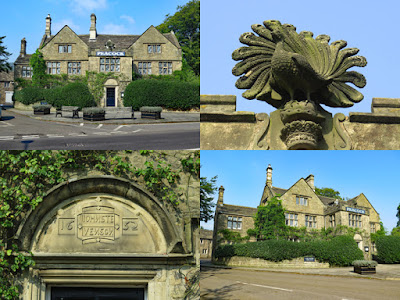With my objective to see some large slabs of Mandale limestone at the yard of Natural Stone Sales Ltd in Rowsley achieved – where I was able to get a much better idea of its variation in colour and texture – I made the most of a fine sunny afternoon to briefly explore the village, before catching a bus back to Bakewell.
 |
| Details of Rowsley Bridge |
The village is set on the A6 at the confluence of the River Derwent and its tributary - the River Wye - which has followed the outcrop of the Bowland Shale down from Bakewell. To the east, the Carboniferous limestone forms scenery typical of the Derbyshire Dales and to the west, the Ashover Grit and Chatsworth Grit form high moorlands.
 |
| General views of architecture in Rowsley |
To the south of Rowsley, near Stanton in the Peak and Darley Dale, there is a concentration of quarries that works buff coloured medium grained gritstone from the Ashover Grit and the stone for St. Katherine's church, built in 1854, and the various vernacular buildings have most likely been sourced from here.
 |
| The old railway station in Rowsley by Joseph Paxton |
The village prospered from mills that were located on both of the rivers and from a large railway marshalling yard that grew up on the Manchester, Buxton, Matlock and Midland Junction Railway. The old railway station, designed by Joseph Paxton – gardener to the Duke of Devonshire at nearby Chatsworth House and designer of the Crystal Palace – now forms the centrepiece of the modern Peak Village shopping centre.
 |
| General views of the Peacock Hotel |
The most interesting historic building by far is the Grade II* Listed Peacock Hotel, built in 1652 for the Manners family – the owners of nearby Haddon Hall. Constructed in gritstone ashlar, with simple mullions and transoms windows and with a stone slate roof, it is adorned by a fine inscription above the doorway and a finely carved peacock – the Manners family crest.
 |
| An old lamp standard in Rowsley |

No comments:
Post a Comment